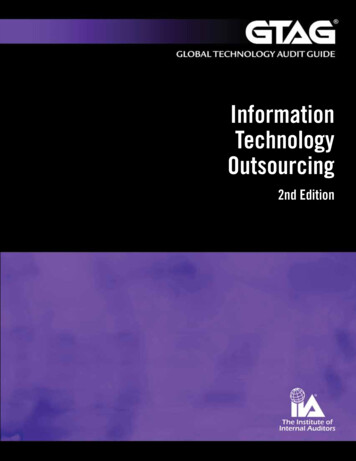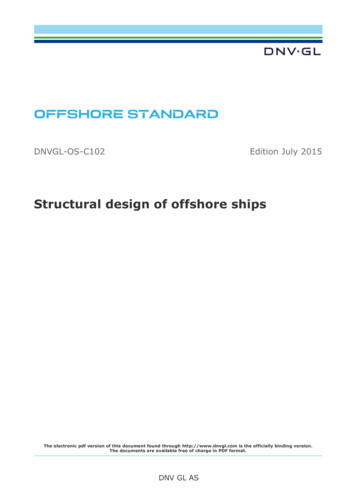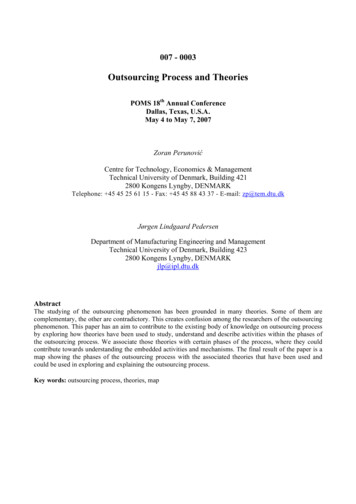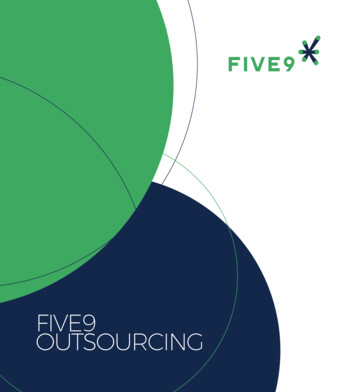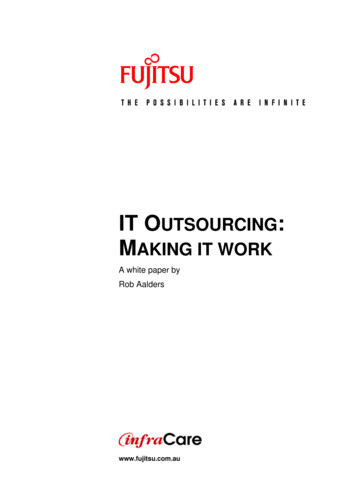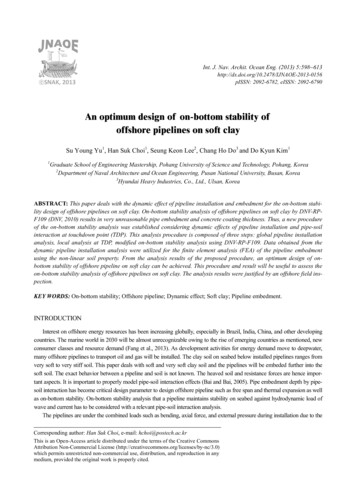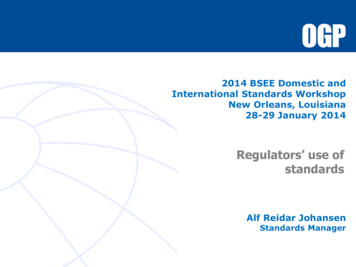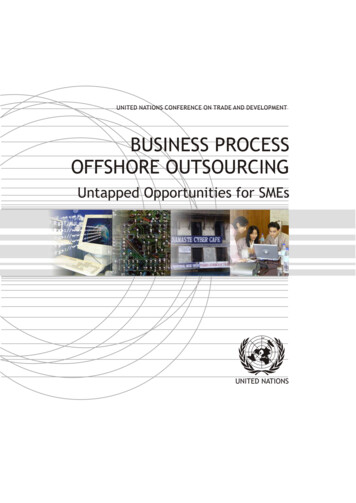
Transcription
BUSINESS PROCESSOFFSHORE OUTSOURCINGUntapped Opportunities for SMEs
UNCTAD/SDTE/TIB/2005/6United Nations Conference on Trade and DevelopmentBusiness Process Offshore OutsourcingUntapped Opportunities for SMEsGuide for SME ManagersPrepared by the UNCTAD secretariatUnited NationsNew York and Geneva, 2005Page 1 of 42
NOTE Symbols of United Nations documents are composed of capital letterscombined with figures. Mention of such a symbol indicates a reference to aUnited Nations document. The designations employed and the presentations of the material inpublication do not imply the expression of any opinion whatsoever on theof the Secretariat of the United Nations concerning the legal status ofcountry, territory, city or area, or of its authorities, or concerningdelimitation of its frontiers or boundaries. Websites and webpage addresses quoted in this publication may change orcease to exist owing to the constantly changing nature of the Internet. Material in this publication may be freely quoted or reprinted, butacknowledgement is requested, together with a reference to the documentnumber. A copy of the publication containing the quotation or reprint should besent to the UNCTAD secretariat.Page 2 of 42thispartanythe
ACKNOWLEDGEMENTSThe publication has been prepared by Philippe D. Monnier, an UNCTAD consultant.It is an outcome of a series of UNCTAD national and regional training events on theuse of the Internet for international trade as well as of the author's research on andexperiences with business process offshore outsourcing in developing anddeveloped countries.Valuable inputs have been received from Vlasta Macku, Michiko Enomoto and CoraMezger. The cover was designed by Diego Oyarzun Reyes.The publication has benefited from the experience of people who were interviewedas well as from the information on websites of many companies and organizations.The financial support of the Government of Japan is gratefully acknowledged.Page 3 of 42
CONTENTSNOTE . 2ACKNOWLEDGEMENTS. 3CONTENTS. 4OBJECTIVE OF THIS PUBLICATION . 5CHAPTER 1 . 8THE BPOO MARKET. 81.2.3.4.5.6.7.HOW BIG IS THE BPOO INDUSTRY WORLDWIDE? . 8WHAT ARE THE KEY TRENDS IN BPOO ACTIVITIES?. 8WHAT ACTIVITIES CAN BE OUTSOURCED OFFSHORE? . 10HOW TO CLASSIFY ACTIVITIES THAT CAN BE OUTSOURCED OFFSHORE? . 12WHAT TYPE OF COMPANIES IS PROVIDING BPOO SERVICES? . 13WHAT TYPE OF COMPANIES IS USING BPOO SERVICES? . 15WHICH COUNTRIES ARE THE MAJOR PROVIDERS OF BPOO SERVICES? . 16CHAPTER 2 . 20BENEFITS AND RISKS ARISING FROM BPOO . 201.2.3.WHAT ARE THE ADVANTAGES FOR COMPANIES THAT OUTSOURCE OFFSHORE AND BPOO PROVIDERS?. 20WHAT RISKS DO COMPANIES OUTSOURCING OFFSHORE FACE? . 21THE POLITICAL DISCUSSION: WHO IS THE WINNER COUNTRIES, THAT ARE PROVIDING BPOO SERVICESOR THOSE USING BPOO SERVICES?. 23CHAPTER 3 . 25SUCCESS FORMULAS FOR BPOO PROVIDERS. 251.2.3.HOW CAN POTENTIAL BPOO SERVICE PROVIDERS SELECT SUITABLE SERVICES TO OFFER?. 25HOW CAN BPOO SERVICE PROVIDERS CREDIBLY PROMOTE THEIR SERVICES? . 26WHAT CAN DEVELOPING COUNTRIES DO TO SUPPORT THEIR BPOO SERVICE PROVIDERS? . 28ANNEX: MINI CASE-STUDIES . 301.2.3.4.5.6.MAGNET WEB PUBLISHING, MUMBAI, INDIA . 30ORVISIONS, BANGKOK, THAILAND . 33LANGUE ET BUSINESS, LOME, TOGO . 36NATIONAL INFORMATION TECHNOLOGY INSTITUTE, KATHMANDU, NEPAL . 38DIGITAL DIVIDE DATA, PHNOM PENH, CAMBODIA . 40IBONIA, ANTANANARIVO, MADAGASCAR. 42Page 4 of 42
OBJECTIVE OF THIS PUBLICATIONThe primary purpose of this publication is to be useful to SMEs in developing andleast developed countries willing to sell business process services to organizations inthe developed world. However, this publication could indirectly be useful to any largeor small organization from either the public or the private sector.While the focus of this publication is on the interests of SMEs in developing countries,it also takes a detailed look at buyers of outsourcing services located in developedcountries. The rationale is that it is essential for service providers to gain an intimateunderstanding of their clients' behaviours and motivations.The publication presents case studies to illustrate how SMEs in developing cansuccessfully provide business process services to organizations and internationalcompanies in the developed world.The publication draws primarily on the author’s nearly 10 years of practicalexperience and the many interviews with companies in developed, developing andleast developed countries. Secondary sources are used to supplement and supportthe experiences of the author.This manual can be seen as an extension of the "Use of the Internet for EfficientInternational Trade: A Guide for SME Managers,1” a publication by the same authorand also published by UNCTAD.1UNCTAD/SDTE/TIB/2003/3. The publication can be downloaded free of charge from the UNCTADwebsite (www.unctad.org).Page 5 of 42
INTRODUCTIONWhat does business process outsourcing (BPO) mean? Simply put, it means thetransfer to third parties of the performance of service-based functions once carriedout within a company, or more generally, within an organization.BPO can occur onshore (i.e. within national borders) or offshore, that is in (remote)foreign countries. In this manual, we refer specifically to offshore BPO, hence theterm business process offshore outsourcing (BPOO). Special emphasis has beenplaced on the BPOO occurring in developing and least developed countriesIt is not a new phenomenon for companies to outsource part of their activities todeveloping countries. Until recently, the major scope of these outsourcing activitieswas manufacturing and assembling. One well-known example is the multitude ofMexican "maquiladoras" (i.e. export assembly plants) located near the United Statesborder and working for US companies. However, over the last decade theoutsourcing of services in developing countries has become more and moreimportant thanks to the rapid development of the Internet and the acceleratingdigitization trend. Outsourcing of services is now comparable with the relocation ofmanufacturing activities in terms of its importance in the corporate strategic agenda.The following are the main trends in BPOO activities over the last decade:(a) BPOO has gained in importance for the economies of developed, developing andleast developed countries. Without any doubt, this importance will increase further.(b) BPOO has become more important primarily thanks to two technical advances: The availability of low-cost (high-speed) data networks, primarily the Internet; The widespread digitization of texts, images, sounds and videos. In otherwords, by having digitized files, it is easy to send them at very low costvirtually anywhere in the world.(c) As a consequence of the two aforementioned technical advances, an increasingnumber of corporate functions have become mobile, that is outsourceable offshore.Besides, the sophistication of these "relocable" functions has been increasingsteadily: not only simple functions such as entering data or answering simple phonecalls are outsourced to remote countries but also complex tasks such as financialanalysis. In a way, there is a real globalization of white-collar jobs.(d) BPOO is now a strategic option not only for large organizations: SMEs in bothdeveloped and developing countries have much to gain as well.Page 6 of 42
This manual is structured in the following way. Chapter 1 focuses on the BPOOmarket, describes what activities can be outsourced offshore and analyses whatcountries are particularly strong in the provision of such services. Chapter 2 looks atbenefits and risks arising from BPOO, especially for the companies that outsourceservices offshore, and briefly also for BPOO providers. The same chapter shedssome light on the current political discussion about the potential consequences ofBPOO at the national level. Chapter 3 presents a number of recommendations forcompanies wishing to engage in the provision of business process services, and, to alesser extent, lists some measures by Governments that could help companies intheir countries sell such services on a competitive basis. The Annex illustrates someinteresting cases of SMEs from developing countries that have been successful inselling business process services to developed countries.Page 7 of 42
Chapter 1THE BPOO MARKETThis chapter gives an overview of the BPOO industry, providing estimates of itsvolume and growth perspectives and outlining major trends in BPOO activities.Examples help to illustrate the breadth of activities that can be outsourced offshore,and what kind of companies are providing and using BPOO services. At the end ofthe chapter, characteristics, strengths and weaknesses of the countries that havebecome the main BPOO services providers over last years are examined.1.How big is the BPOO industry worldwide?"70% of General Electric's work would be outsourced.Of this amount, 70% would be done in offshore developmentcentres, and of this amount about 70% would be done in India."Jack Welch, former CEO of General Electric.2BPOO is already a major industry, but it continues to grow. Here are some figuresand forecasts:2. According to an estimate by the management consultancy McKinsey andCompany, BPO was worth US 32 to 35 billion in 2002, that is just 1 per centof the market for business functions that could be performed remotely, 3estimated at US 3 trillion. On the basis of a consensus estimate by the market research firms AberdeenGroup, Gartner and IDC, the BPO market is projected to grow by 35 to 40 percent annually over the next five years.4 According to the management consultancy Mercer Management, 5 offshoreoutsourcing of services was projected to reach US 143 billion by 2005.What are the key trends in BPOO activities?There are two major trends:Trend 1: New and unexpected BPOO activities are appearing.2“The cusp of a revolution: How offshoring will transform the financial services industry, DeloitteResearch, 2003.3Vivek Agrawal & Diana Farrell. “Who wins in offshoring”, McKinsey Quarterly, 2003, No. 4.4Idem.5David Bovet & Andrew Chadwick-Jones. "Outsourced but not out of mind", Mercer ManagementJournal, November 2004.Page 8 of 42
As an example, in the newspaper industry it was commonly thought that editorialfunctions could never be outsourced offshore, partly because of the local culturalelements linked to this activity. However, in 2004, there were tremendous changes.It started with IT magazines such as Builders.com (www.builders.com), a CNETNetworks website aimed at application developers. Builders.com has started tooffshore to India the writing of many of its articles, explaining that one of the benefitsof doing so is the advantage of dealing with a single source instead of having to dealwith many (US) freelancers.Furthermore, Reuters has transferred part of its editorial staff from London and NewYork to Bangalore, from where the small and mid caps quoted companies will becovered. Reuters said it could eventually have as much as 10 per cent of its totalworkforce in India. In the Spanish-speaking area, Spain's newspapers have alsostarted to outsource part of their editorial work to journalists in Argentina, Chile andColombia.Other interesting examples can be found in the medical world. Mr. Mankiw, PresidentBush's Chief Economic Advisor, quoted the case of radiologists in India analysing theX-rays, sent via the Internet, of American patients. Indeed, near Bangalore's airports,at the office of Wipro Ltd, five radiologists interpret 30 CT scans a day for theMassachusetts General Hospital.6Trend 2: The sophistication of BPOO activities is increasing.As an example, General Electric (GE) has 11,000 employees in India. They areprimarily agents in call centres but recently GE also established a core of about 400people who analyse credit card data and market trends.BPOO is being increasingly used for complex financial analysis. For instance,brokerage firms such as Lehman brothers Inc and Bear Stearns & Co are usingIndian financial analysts for number-crunching work. In Chennai, Office Tiger(www.officetiger.com), a New York-based research provider offers research andfinancial analyses to six of the top 10 global investment banks. It employs 200management graduates and chartered accountants, and another 400 graduates andpostgraduates.6"The great hollowing-out myth", Economist, 19, February 2004.Page 9 of 42
3.What activities can be outsourced offshore?Many activities can be outsourced offshore. Functions that require few interactionsand little management attention are prime candidates for outsourcing. Examples ofthe most frequently outsourced activities include:(a) Customer interaction centres (i.e. call centres, contact centres). An example ofsuch a centre is Togo's CAFÉ Informatique (www.cafe.tg)Togo's CAFÉ Informatique provides call centre services to US phone companies(b) Data entry and conversion services, including medical transcriptions.Examples of such service providers are the Philippines-based Medi-Type(www.medi-type.com) and Nepal's National Information Technology Institute Pvt. Ltd.(see mini-case study no. 4 in chapter 5).Medi-Type provides all types of transcription services(c) Finance and accounting services, including billing, collection, tax preparation,claims processing, statutory reporting, equity research, and patent writing andevaluation.(d) Architectural services, that is turning basic layouts into detailed specifications andblueprints. For this purpose, California-based Fluor Corp. (www.fluor.com) employsPage 10 of 42
1,200 engineers and draftsmen in the Philippines, Poland and India. In Viet Nam,Atlas Industries (http://atlasindustries.com) employs about 85 staff, many of themVietnamese architects and engineers.Viet Nam's Atlas helps British architects fill the skills gap during their busy periods.(e) Translation services. In Elance (www.Elance.com), for instance, the leading webbased services marketplace, more than 400 translation service providers are listed.Several hundred translation providers offer their services in Elance.(f) Prepress and digital pre-media services. These services include typesetting, pagecomposition, graphic design, proofing and image scanning.(g) Geographic Information System (GIS) services. See mini-case study no. 4 aboutNepal's National Information Technology Institute Pvt. Ltd.Page 11 of 42
(h) Human resources services such as payroll processing. These services includecompensation processing, recruiting and interviewing, advanced analyses andresource planning.(i) Insurance services. These services include insurance adjustment, claimprocessing and management, and subrogation.(j) Distance learning services. These services include course development,moderation, coaching and grading.(k) Marketing, advertising and PR services, such as the development of advertisingconcepts and marketing plans, product/brand management, sales management andpublication production.(l) Legal services. These services include most steps required in case preparation.The only services that cannot be outsourced are those that absolutely require faceto-face contacts such as the presence of lawyers in a court of law (at least for thetime being). However, as mentioned above, BPOO service providers can providelitigation support services. This is, for instance, the case of Togo-based Lawyers’Office Agboyibo, whose clients are reputable French law offices.4.How to classify activities that can be outsourced offshore?One possible criterion for a classification is the degree of complexity of the specificservice. The list below ranks BPOO services from the most simple to the highlycomplex. Data entry and conversion such as medical transcription. Processing based on pre-set rules. An example of processing would be todecide whether a passenger is allowed to upgrade to first class. Own judgement-based problem solving. Examples include legal advice,decisions whether an insurance company should reimburse a claim andcorporate creditworthiness evaluation.A dimension which is parallel to the degree of complexity is the level of (foreign)language skills required. It ranges from "no skill required" to "perfect masteryneeded". For this reason, call centres focusing on US customers train their operatorsin American culture, linguistics and pronunciation. The purpose is to give theimpression to their counterparts that call agents are located in the United States.Sometimes, call centre agents even adopt American names. Finally, to promote Indiaas a BPOO destination, Kiran Karnik, President of India's National Association ofPage 12 of 42
Software and Service Companies (Nasscom) likes to say that "there are lots ofpeople who not only speak in English, they actually think in it".7Another dimension refers to whether BPOO services must be processed online (i.e.on the spot) or not. Online activities essentially are call centres. In the case of offlineactivities, the raw information is usually sent through the Internet, but it can then beprocessed offline. A typical example of offline processing is translation. Onlineactivities naturally require a much more powerful and reliable infrastructure.5.What type of companies is providing BPOO services?Many big BPOO providers are affiliates of large groups. For instance, Mumbai-basede-Serve International Ltd (www.eservenet.com), established in 1992 and employing5,000 people, is an affiliate of Citigroup. Its annual revenues amount to US 60million and it provides back-office services to Citigroup companies located in over 36countries. A similar example is the India-based Scope (3,300 employees, revenues ofUS 65 million), which is owned by Standard Chartered. In the industrial field,General Electric (GE) has 11,000 Indian employees, the majority of them involved inproviding business process services to other GE affiliates.Other BPOO providers are large independent companies such as India's Wipro(www.wipro.com), Infosys (www.infosys.com) and Tata Consulting Services(www.tcs.com). There are, however, many mid-sized companies such as Cambodia'sDigital Divide Data (www.digitaldividedata.com; see mini-case study no. 5) andNepal's ServingMinds (www.servingminds.com.np; see below).ServingMinds Pvt Ltd is a multimedia contact centre based in Kathmandu.However, there are also a multitude of small independent companies, which provideBPOO services. While many of these small companies are short-lived, many othersare successful, as we will see in the mini-case studies in the Annex.7Phil Reeves, "India: White collar jobs outsourced to South Asia", Independent, 29, August 2003.Page 13 of 42
As a reference, some large and leading BPOO companies are briefly described intable 1.Table 1. Some leading BPOO companies8Company rsBangaloreTata Consulting Services(tcs.com)MumbaiWNS Global Services(wnsgs.com); formersubsidiary of BritishAirwaysMumbaiWipro Spectramind(wipro.com/spectramind)New DelhieFunds GlobalOutsourcing(efunds.com)Arizona, USATechbooks(techbooks.com)Fairfax,Virginia, USAeServe International(affiliate of Citibank),(eservenet.com)USADaksh eServices(IBM resencein 15countrieson fourcontinentsPresencein 32countrieson fivecontinentsIndia(Mumbai,Pune,Nashik)India (NewDelhi,Mumbai,Chennai,Pune)India, USA,UK,Canada,AustraliaDelhiEmployeesKey servicesReferenceclients35,000(not onlyBPO)IT servicesand BPO(finance,insurance,telecom)Overall BPOas well as argo supportservices,CRMPredominantly t onlyBPO)4,0008,5004,000 Financial &retail services1,750Predominantly publishingservicesMumbai,Chennai5,000New DelhiIndia (NewDelhi,Mumbai),Philippines5,000Larsen & ToubroInfotech umbai,LondonHCL Techonolgies BPO(hclbpo.com)Noida (India)India(severallocations),Malaysia,Difficult toassessbecause ofthe management,cardprocessingCustomerservices (e.g.web-basedservices,real-timechat, e-businessPredominantly voiceoffering8Source: primarily the companies’ corporate websites.Page 14 of 427 Fortune"Top 10"companiesBoeing,Ericsson,SonyCitigroupcompanies inover ColumbiaGas, Pratt &WhitneyFortune "Top500" andglobalplayers in an
Company (website)EXL Service(exlservice.com)MsourcE (msource.net)OperationalheadquartersUSA (butoriginallyfrom Noida(India)New York,USAICICI Onesource(icicionesource.com)(majority owned by thefinance ICICI Group)MumbaivCustomer(vcustomer.com)Seattle, USA6.Locations(operationcentres)UKEmployeesKey bai3,200Call centresFedex,Pfizer, NEC,Samsung3,850Predominantly voiceofferingIncludeFortune 500and FTSE100(FinancialTimes StockExchangeIndex)companies inthe financial,telecom,media, retailand tourismsectorsIndia(Delhi,Pune)3,200Predominantly technicalsupportarray ofindustriesWhat type of companies is using BPOO services?Large companies in the United States and in Europe - in particular in the UnitedKingdom - have so far been the most active BPOO service buyers. According toGartner, BPO expenditures will reach 234 billion in 2005, with the United Statescontributing about 60 per cent and European countries about 30 per cent. 9According to McKinsey & Company,10 companies in the United States and UnitedKingdom account for roughly 70 per cent of the BPO market. Relatively liberalemployment and labour laws give companies the necessary flexibility to implement aBPOO strategy, including the restructuring of their activities and their workforce. Theycan also take advantage of the sizeable English-speaking populations in many lowwage countries, such as India, the Philippines and South Africa.In addition to large companies, many SME and individuals are now also takingadvantage of BPOO opportunities. As an example, an increasing number of USSMEs and also individual American citizens have their tax return forms prepared inIndia. For that purpose, they scan the relevant documents and send them using the9"Business process outsourcing: A source of competitive advantages?", DTZ Research, 2003"Offshoring and beyond", McKinsey Quarterly, 2003 No. 3.10Page 15 of 42
Internet to Indian companies such as DeftPro (www.deftpro.com; see below) oraBridgeBPO (www.abridgebpo.com).Taxation-related services provided by India's DeftProEvery company can consider BPOO opportunities and analyse which functions couldbe outsourced offshore. As a matter of fact, many services can be provided fromanywhere.Nowadays, even companies in developing countries start to outsource offshore.BPOO providers themselves outsource part of their work to countries with lowerwages or to countries where the manpower can provide skills (such as foreignlanguages) not easily available at home. As an example, India's InfosysTechnologies Ltd's back office subsidiary Progeon has opened a centre in the CzechRepublic, while MphasiS BFL Ltd's arm MSourcE has established a contact centre inMexico. Finally, WNS Global Services, India's largest independent service firm, hasopened a centre in neighbouring Sri Lanka in 2004.7.Which countries are the major providers of BPOO services?As of today, the main country providing BPOO services is India. In this country, theoutsourcing industry had revenues in 2004 to the tune of US 3.6 billion,mushrooming in and around key cities such as Bangalore, Mumbai and New Delhi. Inthis sector, 245,000 people are employed, six times more than five years ago.11 Anon-exhaustive list of BPOO providers can be found at www.bpoindia.org. In addition,as illustrated in figure 3, several thousands Indian companies are offering theirservices online in Elance (www.elance.com), the world's leading BPOO web-basedmarketplace.11Hindu Business Line, 3, September 2004, as well as the Gartner Group.Page 16 of 42
Several thousands Indian companies are offering their services in Elance.Other BPOO powerhouses include the Philippines, Malaysia, Viet Nam and SouthAfrica. However, there are large BPOO service providers in many other countriessuch as Ghana, where Dallas-based Affiliated Computer Services Inc. (www.acsinc.com) employs more than 1,300 workers at a data-entry site in the city of Accra.12As a location for BPOO service providers, each country/region has its strengths andweaknesses as illustrated in table 2, which is based on the author's research,interviews and work experience. The table shows examples and does not representan exhaustive list.12International Herald Tribune, 23, May 2003.Page 17 of 42
Table 2. Locations for BPOO services: Strengths and weaknesses of majorcountries/regionsCountry/regionIndiaAreas of focusCall centres; IT services.ChinaHardware design;embedded software; callcentres for Japan andRepublic of Korea aregrowing in coastal cities.PhilippinesIT, accounting, architecture,telemarketing.MexicoIT and engineering.Costa RicaCall centres targetingSpanish-speakingconsumers in the USA andin Europe.Call centres in French(because of the presence ofmany French-speakingAfricans).IT services.South AfricaEastern Europe(Hungary,Poland, CzechRepublic,Romania)RussiaFederationComplex IT services; R&Dcentres.Page 18 of 42Some strengths & weaknessesEnglish-language; highly qualifiedpersonnel; enormous labour pool.High telecommunication costs;infrastructure sometimesunreliable.Low costs. Insufficient (but fastimproving) command of theEnglish language. Concerns canarise with regard to theimplementation of intellectualproperty rights.Good fibre-optic infrastructure innine IT parks. Good supply ofEnglish-speaking, collegeeducated accountants, softwareengineers, architects,telemarketers and graphic artists.Above-average understanding ofthe US market.Good supply of IT experts andengineers; proximity to the USA.Command of the Spanishlanguage.Command of the Frenchlanguage. European time zonecompatibility. Limited skill pool.Command of the English andGerman languages. Corruptioncan be an obstacle in somecountries.Enormous untapped pool ofmaster's degrees and doctoratesin sciences, IT and mathematics.Corruption can be an obstacle.
Table 3. Four-stage pattern in BPOO locationsAsia-PacificAmericasStage 1:InfancyPakistanRep. of KoreaBrazilChileVenezuelaBulgariaRomaniaStage 2:EmergingMalaysiaThailandViet NamJamaicaStage 3:EscalatingChinaPhilippinesMexicoStage zechIsraelRepublicUKHungaryPolandSouth AfricaAccording to DTZ Research (www.dtz.co.uk), a firm of international property advisers,BPOO locations follow a four-stage pattern based on an assessment of key elementssuch as labour costs/skills as well as availability/quality of IT and other infrastructure.Therefore, each country can be placed in one stage as illustrated in table 3.13Europe,Middle East &Africa13Russian Fed,Ukraine"Business process outsourcing: A source of competitive advantages?", DTZ Research, 2003.Page 19 of 42
Chapter 2BENEFITS AND RISKS ARISING FROM BPOOThis chapter will look at the benefits and risks of engaging in BPOO activities
United Nations Conference on Trade and Development Business Process Offshore Outsourcing Untapped Opportunities for SMEs . selling business process services to developed countries. Page 7 of 42 . Chapter 1 . According to the management
